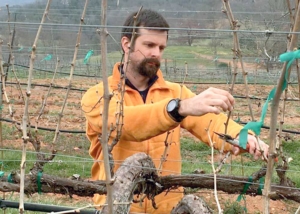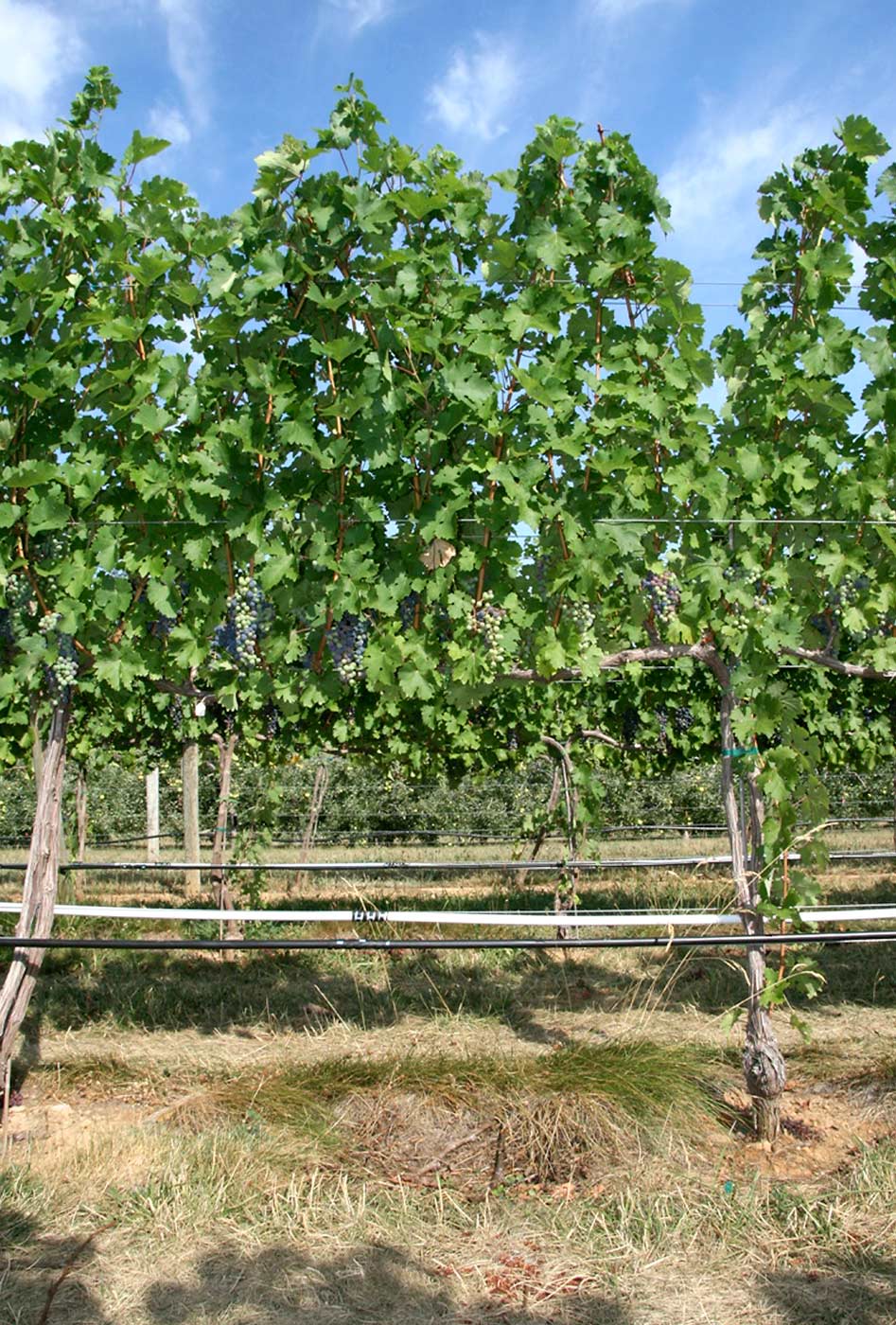
Cain Hickey, Ph.D., viticulture extension specialist at the University of Georgia, was part of a six-year study to examine different vigor-control methods. (Photo courtesy of Cain Hickey)
Every grape grower wants vines that need little attention but yield a bounty of perfect fruit. Often the hinge point between a good year and a bad year is vigor: too much plant vigor means more time pruning, while too little means fewer first-rate grapes.
Growers got some insight into what they can do to tip the scales at the December 2017 Great Lakes Fruit, Vegetable and Farm Market EXPO in Grand Rapids, Michigan.
There, Cain Hickey coalesced the results of a
six-year study on how cover crops under the trellis, rootstock selection and root-restrictive bags affected vigor.
“This doesn’t offer a silver bullet, but these are potential tools that offer more control over the regulation of your vine growth,” said Hickey, who conducted the study as part of Tony Wolf’s Virginia Tech research group and is now a viticulture extension specialist at the University of Georgia.
The U.S. Department of Agriculture Specialty Crop Research Initiative and the Virginia Wine Board funded the study, which ran from 2010-2016.

As part of the vigor-control study, researchers planted cover crops directly under the trellis. Results showed that cover crops affected vine growth differently over time. (Photo courtesy of Cain Hickey)
Cover crops
For the cover crop part of the study, the researchers planted creeping red fescue beneath vineyard trellises, an area most growers keep clear of vegetation through the use of herbicides.
“When you talk about putting two plants close to one another, or in the case of this study, when you plant cover crops right up to the trunk of the vine, people immediately think that there’s going to be competition. That’s why they don’t do it,” Hickey said. What the researchers wanted to find out was whether cover crops might actually confer some benefits.
To determine the effect of cover crops on growth, the Virginia Tech group measured the pruning weight of dormant canes in Cabernet Sauvignon vines grown above cover crops and vines grown above herbicide-treated, bare soil.
Their results showed cover crops significantly reduced growth early in the vine’s life when compared to the bare-soil vines, but that difference in growth became more and more minimal over time, he said. Specifically, pruning weight in cover crop vines was about 55 percent that of bare-soil vines in 2008, but the difference between the two dropped to about 20 percent by 2014.
“We think the reason for the difference in growth was that young vines have very shallow roots; so do the cover crop, so there was probably some competition because they were exploring the same soil niche. But over time, the vine’s roots grow down and into deeper soil profiles and settle in their own niche away from the cover crop roots,” Hickey said.
The researchers also used a pressurized-chamber, plant-moisture sensor to determine how much available water the vines were using.
“You’d think cover crops would compete with vines for water, but we found that the vine’s water status between the herbicide and cover crop vines was the same. What we think was happening was that the cover crops aided rainwater infiltration into the soil and water movement through the soil profile, whereas in the herbicide situation where you have bare dirt, the ground was crusted over and the water was just running off and away, rather than infiltrating into the soil,” Hickey said.
Beyond those results, he also noted that the creeping red fescue went dormant right around the time the grapes were starting to change color and accumulate sugar. “At that point, the cover crops are serving as mulch, which serves to maintain moisture in the soil, whereas water evaporation is anticipated to be much quicker from bare soil,” he said. “So again, we found there’s more than meets the eye with cover crops.”

The study also included the use of use of root-restrictive bags, which proved to be very effective in reducing vine growth, although they also decreased yield. (Photo courtesy of Cain Hickey)
Rootstocks and root restriction
For the rootstock component of the study, the researchers evaluated three popular rootstocks: 101-14, 420-A and Riparia Gloire. Of the three, Riparia Gloire reduced vegetative vine growth the most in terms of dormant cane pruning weight, but tended to produce higher yields than the other two rootstocks, Hickey said.
In terms of fruit composition, the study showed no significant disparity; however 420-A tended to reduce pH and berry color compared to the other two rootstocks.
“Of all three things that we evaluated, though, root restriction (growing vines in 0.015 m3 bags) is certainly your best bet for controlling vigor,” he said. “It largely reduced vine growth especially relative to the regulation that we saw through rootstock choice or cover-crop management.”
At the same time, the root-restricted vines showed a greater reduction in yield and decreased water status especially in dry seasons. The root-restricted vines also had consistently higher phenolics and anthocyanin measurements.
“We think the increased phenolics and anthocyanin had to do with the more-open canopy from the decreased vigor, as well as the lower water status. The decreased vigor let light get to the fruit zone better, and the lower water status generated a smaller berry size, which means a higher surface area to volume ratio and therefore a higher concentration of color compounds,” he said.
Hickey also participated in a side project to evaluate larger-capacity root-restriction bags. Preliminary results from that project show that using 0.026 to 0.058 m3 root-restriction bags appears to regulate vine size and maintain crop yield when compared to conventionally grown vines.
Summing it up
All three of these approaches regulate vine growth, but as growers know, vine growth is a double-edged sword. “If you have too much vigor, you have to go back and spend a lot of labor remedially managing that canopy through pruning or hedging so the vine doesn’t shade itself and the fruiting zone,” Hickey said. “Then again, you can’t have low vigor all the time and expect the crop yield to be maintained at economical levels necessarily.”
He offered this take-home message for growers: “Consider your site and tailor this suite of proactive tools — cover crops, rootstock selection, and root restriction — to reach your management and production goals, including labor time and costs, crop yield and fruit quality.”
He added, “No one vigor-control measure is going to offer the ultimate answer, but by proceeding with caution and combining these tools with conventional hedging and fruit-zone leaf removal, you can begin to determine the combination that works best for you.”
Additional details from the six-year study are published in the American Journal of Enology and Viticulture (Hickey, C. C., Hatch, T. A., Stallings, J., and Wolf, T. K. “Under-trellis cover crop and rootstock affect growth, yield components, and fruit composition of Cabernet Sauvignon,” Am J Enol Vitic. 67:281-295). •
—by Leslie Mertz






Leave A Comment